In this comprehensive guide, you will discover a fundamental overview of solar panel making machines and production processes essential for understanding solar panel creation.
Overview Of Solar Panel Making Machines And Processes
The following graphic shows the complete solar panel manufacturing process and the solar machinery needed for each step. The round bubbles represent the materials entering the process.
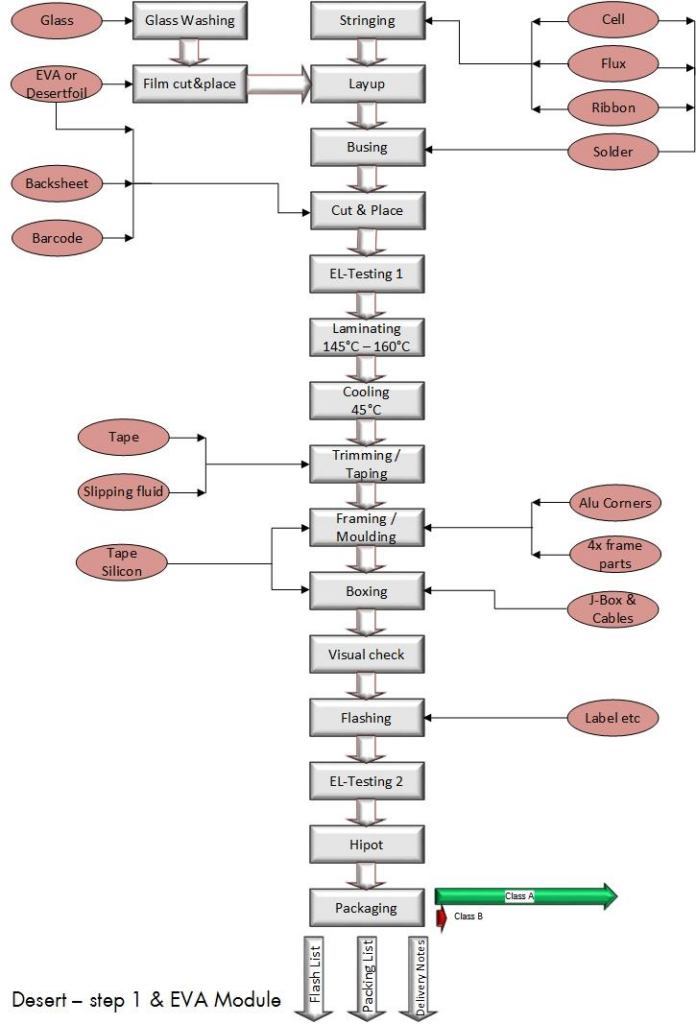
Here is a list of the main solar panel making machines:
- (Glass Washer)
- Foil Cutter
- Stringer
- Layup stations
- Bussing stations
- Laminators
- Foil cutters
- Foil placing stations
- Trimming and taping stations
- J-box stations
- Framers
- High potential tests
- Sun simulators
- Sorting and packing
Each of these solar panel making machines plays an important role. In the following sections, we will briefly summarize how each piece of equipment or parts fits in the production of PV modules.
Stringer
The solar stringer is for connecting individual solar cells together in a series to a string (a row of soldered solar cells).
Stringer Input and Output:
Input:
- Solar cells
- Ribbon for connecting the cells
- Flux to activate the soldering paste
Output:
- String
Stringer Process:
- Checking and alignment of the cell
- Placing cell on soldering belt
- Applying the flux on the ribbon
- Cutting the ribbons
- Placing the ribbons on the cells
- Soldering the solar cells together with infrared soldering process
- Presenting the ready made string
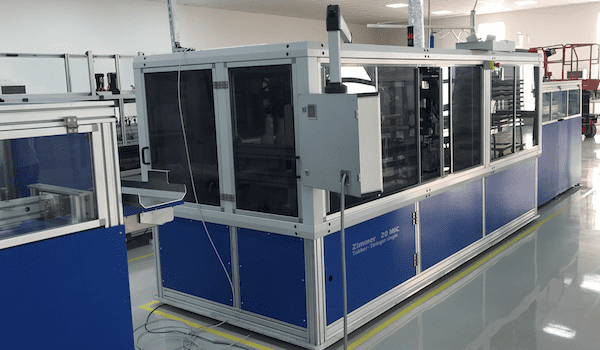
Solar Stringer Machine
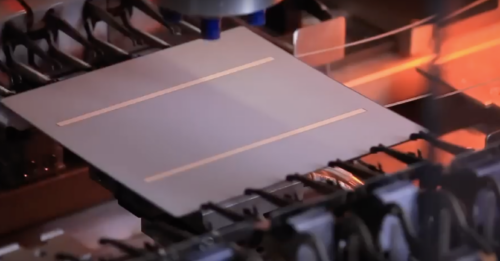
Solar cell on soldering belt without ribbon

Soldering of Solar Cell
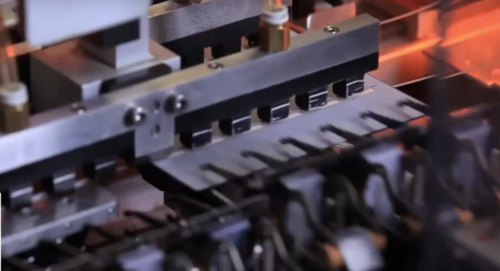
Ribbon Placement on Solar Cell
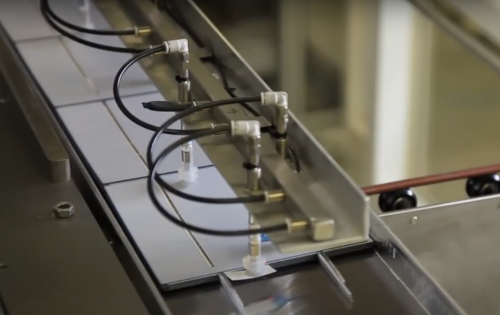
String with Cells and Ribbon
Layup station
The strings that come from the stringer are now placed on the glass — including the lamination foil (normally EVA or DESERT PROCESS FOIL for long life panels in hot areas).
Input and output of Layup machine:
Input:
- Solar glass with foil
- Solar strings (from stringer)
Output:
- Glass covered with foil and strings on top
Process of Layup machine:
- Feed in the solar glass with EVA or DESERT Foil on top
- Alignment and placement of the solar strings on the glass
The result is a solar glass, covered with embedding foil and the solar strings.
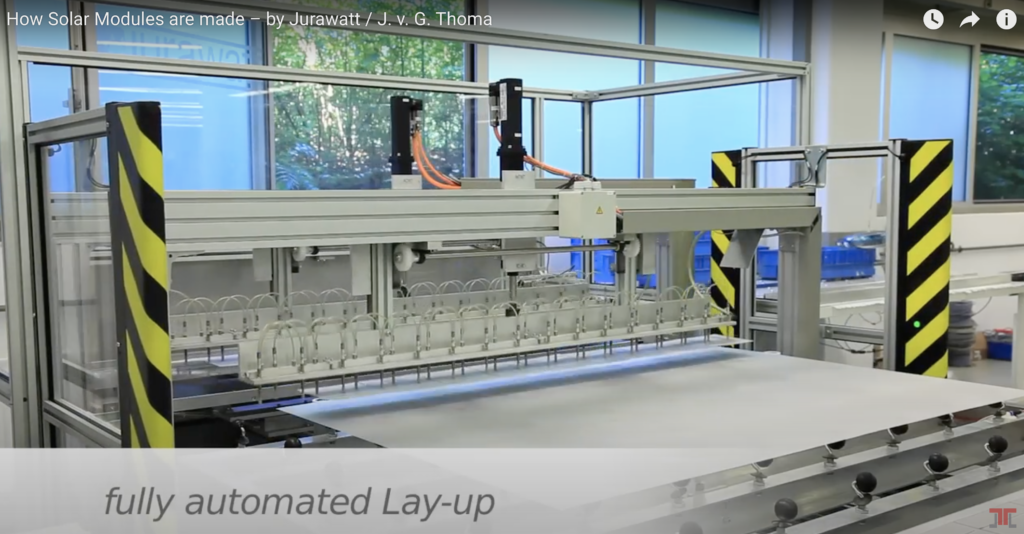
Layup Station for Placing the Strings on the Glass
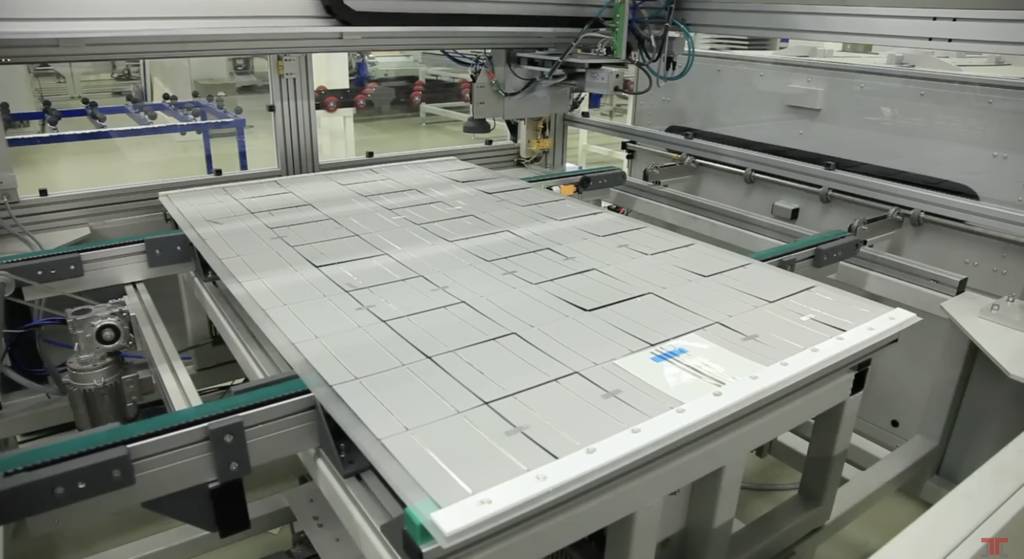
Glass with solar Strings on Top
Bussing Station
The bussing station is where the solar strings on the solar glass are connected to a complete module.
All ribbons are connected in a row so that the power can flow through the complete module and (later) be connected to the plus and minus of the junction box connectors.
Input and Output of Bussing Station
Input:
- Bussing ribbon
- Glass with foil and strings (from layup)
Output:
- Connected strings on glass with foil
Process of Bussing Machine
- Feed in the glass with strings on top
- Placing the bussing ribbon for interconnection
- Soldering the ribbons of the strings with the bussing ribbon
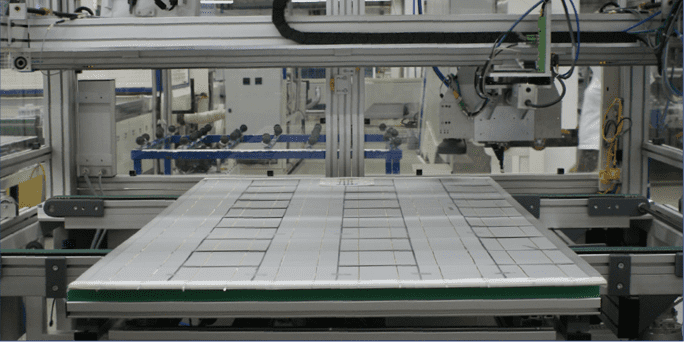
Laminator
After bussing station, the glass with strings are covered by another embedding foil and back sheet foil. This "Glass-Foil-Cell" package then has to be converted to a protected solar laminate. This process is done in the laminator.
Input and Output of Solar Laminator
Input:
- Solar glass, covered with foils and connected solar strings (from bussing)
Output:
- Solar laminate
Process of Solar Laminator
- Feed in the glass-foil-string package in the lamination chamber
- Creating a vacuum with pumping out all air from the laminator chamber
- Pressing and heating the glass and foils to connect the complete package to a solid laminate
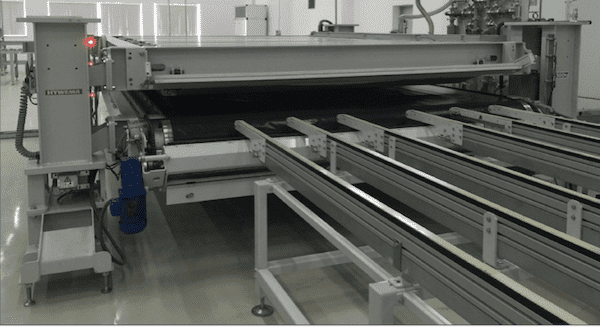
Foil Cutter And Foil Placing Station
The foil cutter and foil placing station are responsible for cutting the backsheet and embedding foil placing the foil. The backsheet is a thin sheet of plastic that is placed on the back of the solar module to protect it from the elements. The embedding foil is a flexible foil that can be melted and connects the glass, cells and backsheet together to a solid laminate.
The foil cutter is responsible for cutting the sheets to the correct size and shape. The foil placing station is responsible for placing the foil on the cells, ensuring that it is correctly aligned and connected.
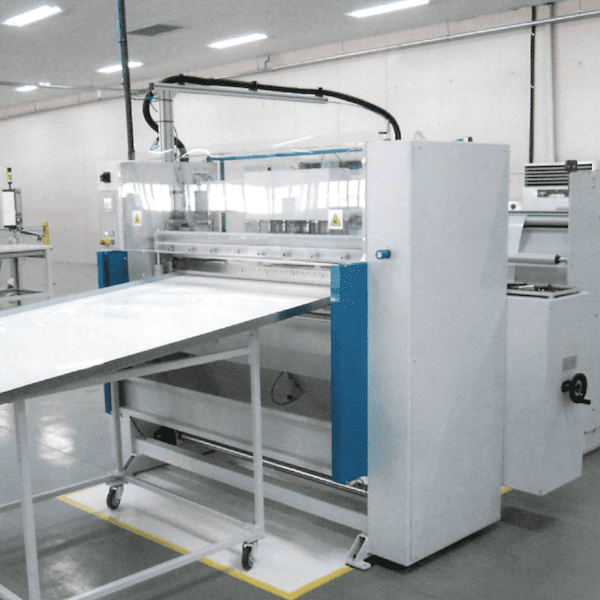
Trimming And Taping Station
At the trimming station, the overspending foil of the laminate is removed. This can be done manually with a knife or fully automated.
After trimming, the laminate corners are covered with a tape. The sticky tape is the connection between the laminate and the frame to make it stronger and water proof.
Input and Output of Trim / Tape Station
Input:
- Untrimmed laminate
- Tape for laminate
Output:
- Trimmed and taped laminate
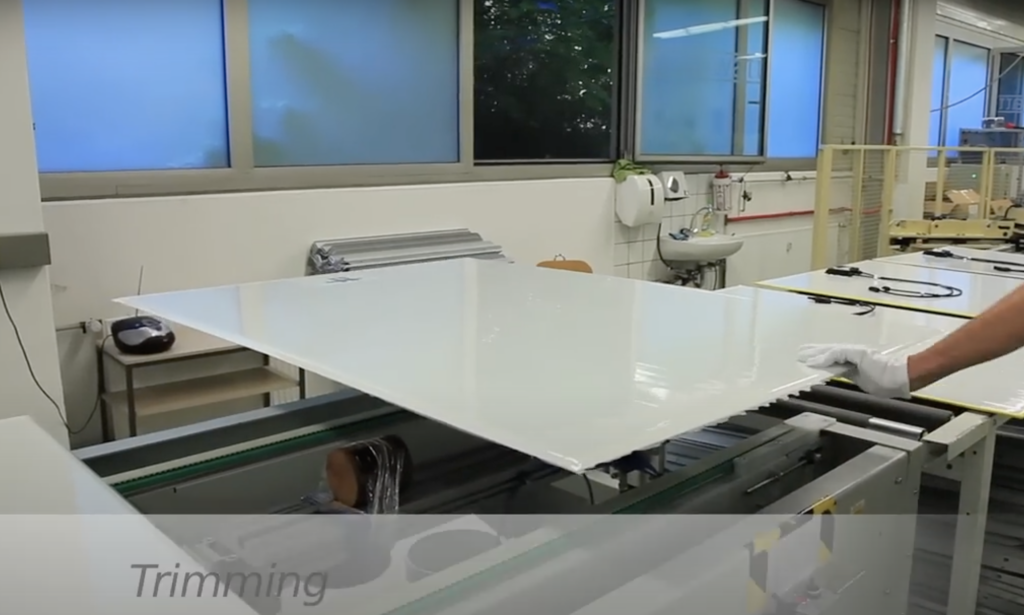
Trim Station with Untrimmed Laminate

Manual Trim of Solar Laminate
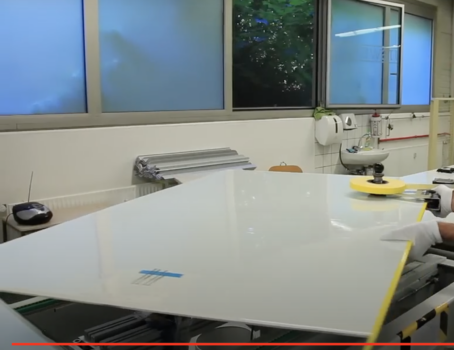
Taped laminate
J-Box Station And Framer
The J-Box station and framers are responsible for connecting the solar module to the J-Box and installing the frame. The J-Box is a junction box that contains the electrical components that connect the module to other modules or to other components of the solar machine.
The framers are responsible for installing the frame, which is necessary for mounting the solar module.
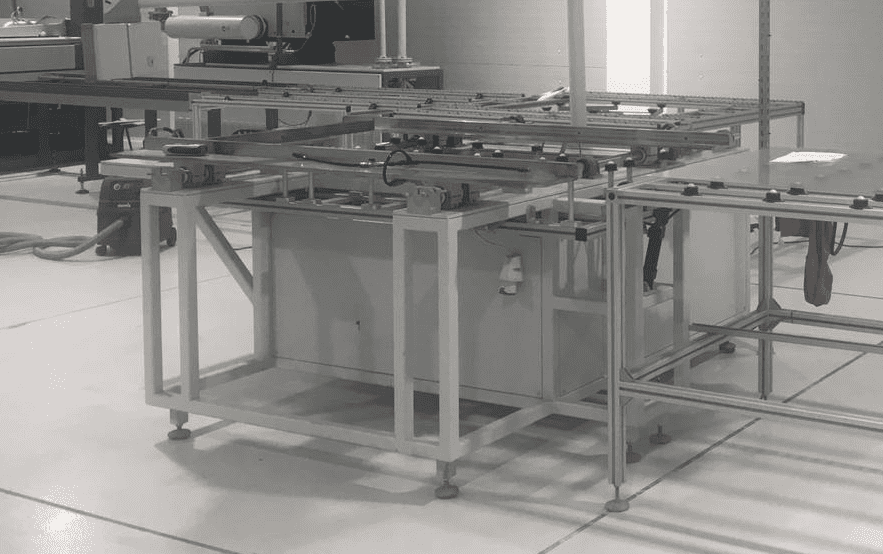
The High Potential Test And Sun Simulator
Testing is an important step in solar module production. Solar modules have to meet certain standards and be able to perform as expected in real-world conditions.
The high potential test and sun simulator are responsible for testing the quality of the solar module. The high potential test measures the voltage of the module, while the sun simulator simulates the effects of sunlight on the module.
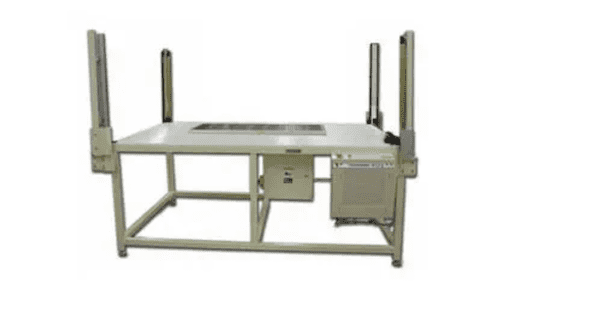
Sorting And Packing
The final step in producing solar modules is sorting and packing. This involves sorting the modules into different categories, such as wattage, voltage, and size. It also involves packing the modules into boxes for storage or shipping.
Recent Developments In Machine Design
Developments in solar panel production machines have been driven by the need for higher efficiency and lower costs. One of the most significant developments is the use of automated production lines. These lines consist of several machines working together to produce solar panels from start to finish.
The use of robots and artificial intelligence in solar panel production is also on the rise and will play a big role in further reducing costs and improving efficiency for manufacturers.
The use of advanced machinery and automation in solar panel production has not only led to an increase in efficiency but also a reduction in costs.
In subsequent articles, we will go deeper into each of the main processes as well as the role of automation in solar manufacturing. Make sure to check our blog so you do not miss those articles!

Excellent post! The detailed overview of solar panel manufacturing machines is very informative and highlights the critical technology behind efficient solar panel production. It’s fascinating to learn about the machinery and processes that make solar energy more accessible and cost-effective. At Aeliya Marine, we recognize the growing importance of renewable energy solutions, especially in the maritime industry. This article provides valuable insights into the innovations driving the future of solar power. Keep up the great work!
ارغب في العمل
Technicien maintenance industrielle et construction métallique
Interest to start manufacturing in India. Please suggest me how much budget we need, and I need support, manufacturing facility and processing.
Hi, please fill out our contact form here to get the appropriate details:
https://www.jvg-thoma.de/